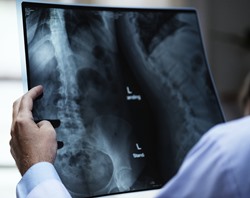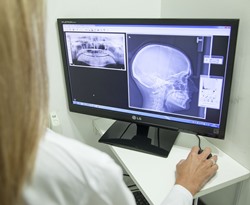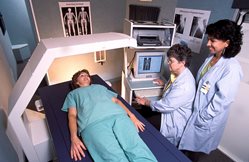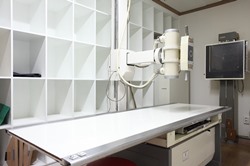How to Select the Right X Ray Tech Program near Maunaloa Hawaii
 So you have made the decision to enroll in an X-ray tech school near Maunaloa HI in order to become a radiology technician. And now that you have made a decision to go into the rewarding field of healthcare, just how do you set about picking the right college and program to ensure that you will obtain the appropriate training to become a skilled professional? And since most states do require that radiology techs become licensed, based on where you ultimately work you might require preparation to pass a licensing test. So it’s essential that you research each of the X-ray technician schools you are considering so that you can evaluate each program. A number of prospective students begin by searching for colleges or technical schools that are within driving distance of their residences. Next, they compare tuition and usually gravitate toward the most affordable cost. But while expense and location must be considered, there are other critical qualifiers also. For example, you must find out if the radiology tech schools are accredited, or if they sponsor internship programs. These inquiries and others you should ask the X-ray Tech schools you are considering are provided later in this post. But first, let’s talk about what a radiologic tech does and the credentials and education options that are available.
So you have made the decision to enroll in an X-ray tech school near Maunaloa HI in order to become a radiology technician. And now that you have made a decision to go into the rewarding field of healthcare, just how do you set about picking the right college and program to ensure that you will obtain the appropriate training to become a skilled professional? And since most states do require that radiology techs become licensed, based on where you ultimately work you might require preparation to pass a licensing test. So it’s essential that you research each of the X-ray technician schools you are considering so that you can evaluate each program. A number of prospective students begin by searching for colleges or technical schools that are within driving distance of their residences. Next, they compare tuition and usually gravitate toward the most affordable cost. But while expense and location must be considered, there are other critical qualifiers also. For example, you must find out if the radiology tech schools are accredited, or if they sponsor internship programs. These inquiries and others you should ask the X-ray Tech schools you are considering are provided later in this post. But first, let’s talk about what a radiologic tech does and the credentials and education options that are available.
X-Ray Tech Job Summary in Maunaloa HI
 There are multiple professional titles for x-ray techs (technicians or technologists). They may also be called radiologic technologists, radiologic technicians, radiology technicians or radiographers. Regardless of the name, each has the same fundamental job function, which is to use imaging machines to internally view patients for the purpose of diagnosis and treatment. A number of radiologic technologists might also provide radiation therapy for treating cancer. Many choose to perform as generalists, while others may choose a specialty, for example mammography. They can practice in Maunaloa HI hospitals, clinics, family practices or outpatient diagnostic imaging centers. The imaging technologies that an X-Ray technologist may work with include:
There are multiple professional titles for x-ray techs (technicians or technologists). They may also be called radiologic technologists, radiologic technicians, radiology technicians or radiographers. Regardless of the name, each has the same fundamental job function, which is to use imaging machines to internally view patients for the purpose of diagnosis and treatment. A number of radiologic technologists might also provide radiation therapy for treating cancer. Many choose to perform as generalists, while others may choose a specialty, for example mammography. They can practice in Maunaloa HI hospitals, clinics, family practices or outpatient diagnostic imaging centers. The imaging technologies that an X-Ray technologist may work with include:
- Traditional and specialized X-Rays
- Computerized tomography (CT) or “CAT” scans
- Magnetic resonance imaging (MRI)
- Sonography or ultrasound
- Fluoroscopy
Radiographers must maintain their equipment plus regularly evaluate its performance and safety. They are also expected to keep in-depth records of all of their diagnostic procedures. As medical practitioners, they are held to a high professional standard and code of conduct.
Click Here For Free Information on X-Ray Tech Schools Near You!
Radiology Tech Degrees near Maunaloa HI
 The basic requirement for enrolling in a radiology tech school is to have received a high school diploma or equivalent. Radiologic technologist pupils have the option to earn either an Associate or a Bachelor’s Degree. An Associate Degree, which is the most prevalent among techs, generally takes 18 months to 2 years to finish depending on the program and course load. A Bachelor’s Degree will take longer at as much as 4 years to finish and is more expansive in nature. Most students select a degree major in Radiography, but there are additional similar majors that are acceptable as well. One thing to bear in mind is that radiographer schools have a practical training or lab component as a component of their curriculum. It can frequently be fulfilled by taking part in an externship program which many schools sponsor through local clinics and hospitals in Maunaloa HI or their area. After you have graduated from any of the degree programs, you will need to abide by any licensing or certification mandates in Hawaii or the state you will be practicing in as applicable.
The basic requirement for enrolling in a radiology tech school is to have received a high school diploma or equivalent. Radiologic technologist pupils have the option to earn either an Associate or a Bachelor’s Degree. An Associate Degree, which is the most prevalent among techs, generally takes 18 months to 2 years to finish depending on the program and course load. A Bachelor’s Degree will take longer at as much as 4 years to finish and is more expansive in nature. Most students select a degree major in Radiography, but there are additional similar majors that are acceptable as well. One thing to bear in mind is that radiographer schools have a practical training or lab component as a component of their curriculum. It can frequently be fulfilled by taking part in an externship program which many schools sponsor through local clinics and hospitals in Maunaloa HI or their area. After you have graduated from any of the degree programs, you will need to abide by any licensing or certification mandates in Hawaii or the state you will be practicing in as applicable.
X-ray Technician Certification and Licensing
After you have graduated from an Radiologist program, depending on the state where you will be working you might have to become licensed. The majority of states do mandate licensing, and their criteria differ so check with your state. At present, all states that do require licensing will accept The American Registry of Radiologic Technologists (ARRT) certification exam for the licensing application, but many offer other alternatives for testing as well. A number of states also require certification as part of the licensing process, otherwise it is voluntary. However, numerous Maunaloa area employers would rather hire radiology techs that are certified so it may enhance your career options in and around Maunaloa HI to become certified. ARRT’s certification program involves graduation from an approved program as well as a passing score on their comprehensive exam. ARRT also demands re-certification every 2 years, which can be satisfied with 24 credits of continuing ed, or by passing an exam.
Online Radiology Tech Programs
 As a part of every degree program, x-ray tech schools will have practical or lab training included in their curriculum. This is the same for online degree colleges. So even though you can still obtain your degree online, a large portion of the training will be completed either in a college lab or in an internship off-campus. Clinical training is typically conducted in Maunaloa HI family practices, medical clinics or hospitals in sponsorship with the colleges. However the online portion of the training can be attended in the privacy of your Maunaloa residence. Students who continue working while earning their degree typically find that the online approach to education is much more convenient with their active schedules. Plus online colleges are frequently less expensive than traditional alternatives. In addition to lower tuition, expenditures for study materials and commuting can be decreased also. But just make sure that the online school you enroll in is accredited (more on the benefits of accreditation later). So if you are dedicated enough to learn with this less structured style of training, then online classes may be the ideal option for you.
As a part of every degree program, x-ray tech schools will have practical or lab training included in their curriculum. This is the same for online degree colleges. So even though you can still obtain your degree online, a large portion of the training will be completed either in a college lab or in an internship off-campus. Clinical training is typically conducted in Maunaloa HI family practices, medical clinics or hospitals in sponsorship with the colleges. However the online portion of the training can be attended in the privacy of your Maunaloa residence. Students who continue working while earning their degree typically find that the online approach to education is much more convenient with their active schedules. Plus online colleges are frequently less expensive than traditional alternatives. In addition to lower tuition, expenditures for study materials and commuting can be decreased also. But just make sure that the online school you enroll in is accredited (more on the benefits of accreditation later). So if you are dedicated enough to learn with this less structured style of training, then online classes may be the ideal option for you.
What to Ask X Ray Tech Colleges
When you have chosen the type of degree that you want to earn, you can initiate the process of searching for and assessing x-ray tech colleges near Maunaloa HI. You will also need to decide if you prefer to attend online classes or commute to a nearby campus. If you opt for the latter, then of course the location of the school will be important. The price of tuition and supplementary expenses will be an important variable also. But in addition to cost and location, what else should you consider when evaluating colleges? Well, you should find out if the colleges are accredited, and if they sponsor externship or internship programs. To help you find out some of these important details prior to making your decision, we have assembled a list of questions that you need to ask the schools you are assessing.
Are the X-Ray Tech Colleges Accredited? Most xray tech colleges have obtained some type of accreditation, whether regional or national. Even so, it’s still important to verify that the school and program are accredited. Among the most highly respected accrediting organizations in the field of radiology is the Joint Review Committee on Education in Radiologic Technology (JRCERT). Schools earning accreditation from the JRCERT have undergone a rigorous assessment of their teachers and educational materials. If the program is online it may also earn accreditation from the Distance Education and Training Council, which targets distance or online learning. All accrediting agencies should be acknowledged by the U.S. Department of Education or the Council on Higher Education Accreditation. Besides ensuring a premium education, accreditation will also help in securing financial aid and student loans, which are many times not available for non-accredited colleges. Accreditation might also be a pre-requisite for licensing and certification as required. And many Maunaloa HI employers will only hire a graduate of an accredited school for entry-level openings.
Are Internship Programs Offered? Ask if the radiology technician schools you are evaluating have partnerships with area clinics or hospitals for internship programs. Internships are not only an excellent manner to get practical experience in a clinical setting, they are additionally a means to fulfill the clinical training requirement for most programs. As an ancillary benefit, they may assist graduates and students develop professional connections in the Maunaloa HI healthcare community and assist with job placement.
Is Job Placement Assistance available? You will most likely wish to secure employment quickly after graduation, but finding that first job in Maunaloa HI in a new profession can be challenging without support. Find out if the radiographer programs you are interviewing have job placement programs and what their success rates are. High and rapid placement rates are an excellent sign that the schools have large networks and good relationships with Hawaii healthcare employers. It also corroborates that their students are highly regarded and in demand.
Where is the Program Located? For a lot of students, the school they choose will need to be within driving distance of their Maunaloa HI residence. Those who have chosen to attend classes online obviously will not have to concern themselves with the location of the campus. However, the availability of area internships will be of concern. Something to consider is that if you choose to enroll in a school that is out of state or even out of your local area, you may need to pay a higher tuition. State colleges usually charge higher tuitions for out of state residents. And community colleges often charge a higher tuition for those students that don’t reside within their districts.
What Size are the Classes ? Unless you are the type of student that likes to sit way in the back of class or hide in the crowd, you will likely prefer a smaller class size. Small classes allow for more individual participation and personalized instruction. Ask the Maunaloa HI colleges you are considering what the average student to teacher ratio is for their classrooms. If practical you may want to sit in on one or more classes before making your ultimate determination. This will also give you a chance to talk with a few of the instructors and students to get their opinions regarding the xray technician program also.
Can the Program Accommodate your Schedule? And finally you must confirm that the radiographer college you finally select can provide the class schedule you need. This is particularly essential if you choose to continue working while you attend school. If you need to schedule evening or weekend classes in the Maunaloa HI area, confirm that they are available. If you can only attend part-time, verify if that is an alternative and how many credit hours or courses you would have to carry. Also, find out what the protocol is for making up any classes that you might miss due to illness, work or family emergencies.
How to Enroll in Weekend X Ray Technician Schools Maunaloa HI
 Enrolling in the best radiology technician college is an important first step toward launching a gratifying new career providing diagnostic medical services to patients. The suitable radiographer must be in good physical shape. X-Ray techs regularly stand for the majority of the working day and move and in some cases lift the patient to obtain the correct image. Candidates must also demonstrate an ability to pay close attention to detail and to follow the safety requirements designed to protect both the medical team and the patient. X-Ray techs work very closely with patients, other technicians as well as the doctors and radiologists. Having interpersonal skills is a must in order to have a good work environment and deliver the best available patient care. You originally came to this website due to an interest in How to Enroll in Weekend X Ray Technician Schools and wanting more information on the topic Top Part Time Radiology Technician Schools. However, as has been discussed in this post, there are several questions that you need to ask each college you are considering prior to making your final selection. This is just as true whether you decide on an online program or travel to classes on-campus. By asking the right questions you can assess and compare each program so you can narrow down your options before making your final choice. And with the right training and your motivation to be successful, you can reach your goal to practice as a radiographer in Maunaloa HI.
Enrolling in the best radiology technician college is an important first step toward launching a gratifying new career providing diagnostic medical services to patients. The suitable radiographer must be in good physical shape. X-Ray techs regularly stand for the majority of the working day and move and in some cases lift the patient to obtain the correct image. Candidates must also demonstrate an ability to pay close attention to detail and to follow the safety requirements designed to protect both the medical team and the patient. X-Ray techs work very closely with patients, other technicians as well as the doctors and radiologists. Having interpersonal skills is a must in order to have a good work environment and deliver the best available patient care. You originally came to this website due to an interest in How to Enroll in Weekend X Ray Technician Schools and wanting more information on the topic Top Part Time Radiology Technician Schools. However, as has been discussed in this post, there are several questions that you need to ask each college you are considering prior to making your final selection. This is just as true whether you decide on an online program or travel to classes on-campus. By asking the right questions you can assess and compare each program so you can narrow down your options before making your final choice. And with the right training and your motivation to be successful, you can reach your goal to practice as a radiographer in Maunaloa HI.
Other Hawaii Diagnostic Locations
Maunaloa, Hawaii
As of the census[5] of 2000, there were 230 people, 65 households, and 52 families residing in the CDP. The population density was 1,374.6 people per square mile (522.4/km²). There were 91 housing units at an average density of 543.9 per square mile (206.7/km²). The racial makeup of the CDP was 15.7% White, 0.3% African American, 18.7% Asian, 34.4% Pacific Islander, and 30.9% from two or more races. Hispanic or Latino of any race were 5.2% of the population.
There were 65 households out of which 50.8% had children under the age of 18 living with them, 56.9% were married couples living together, 18.5% had a female householder with no husband present, and 18.5% were non-families. 13.8% of all households were made up of individuals and 1.5% had someone living alone who was 65 years of age or older. The average household size was 3.54 and the average family size was 3.96.
In the CDP the population was spread out with 43.5% under the age of 18, 8.3% from 18 to 24, 25.2% from 25 to 44, 14.3% from 45 to 64, and 8.7% who were 65 years of age or older. The median age was 22 years. For every 100 females, there were 109.1 males. For every 100 females age 18 and over, there were 94.0 males.
